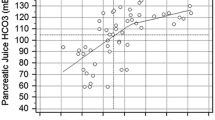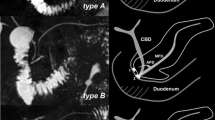Background/Purpose
The aim of this study was to assess the value of magnetic resonance cholangiopancreatography with secretin stimulation (secretin-MRCP) in evaluating the remnant pancreatic exocrine reserve after pancreaticogastrostomy with pancreaticoduodenectomy.
Methods
Forty-three patients who had undergone pancreaticoduodenectomies and who were given pancreaticogastrostomies for reconstruction were studied. Dynamic MRCPs, using a half-Fourier acquisition single-shot turbo spin-echo (HASTE) sequence were obtained before and up to 10 min after secretin administration. The morphologic features and diameter of the main pancreatic duct were monitored and graded before and after secretin stimulation. The results were compared with those of endoscopic findings, secretin stimulation testing with a collection of pancreatic fluid, N-benzoyl-l-tyrosyl-p-aminobenzoic acid (BT-PABA) excretion testing, and fecal chymotrypsin concentration.
Results
The results of secretin-MRCP were classified into three distinct groups: a good-secretion group (group 1; n = 22; 51%), a moderate-secretion group (group 2; n = 10; 23%), and a poor-secretion group (group 3; n = 11; 26%). This MRCP classification correlated significantly with the concentrations of the pancreatic enzymes p-type amylase, lipase, and trypsin in the gastric juice. The BT-PABA test value was 59.8% in group 1, 46.1% in group 2, and 46.5% in group 3, and was significantly higher in group 1 than in groups 2 or 3. The fecal chymotrypsin concentration was 20.5 U/g in group 1, 14.5 U/g in group 2, and 0.7 U/g in group 3, and there was a significant correlation between the MRCP classification and fecal chymotrypsin concentration.
Conclusions
MRCP with secretin stimulation favorably reflected the presence of remnant pancreatic exocrine function. Therefore, secretin-MRCP is a feasible and effective follow-up examination method to evaluate remnant pancreatic exocrine function after pancreaticogastrostomy.
Similar content being viewed by others
Author information
Authors and Affiliations
Additional information
Presented at the Fifth World Congress of the International Hepato-Pancreato-Biliary Association, Tokyo, Japan, April 25–29, 2002.
About this article
Cite this article
Shinchi, H., Takao, S., Maemura, K. et al. Value of magnetic resonance cholangiopancreatography with secretin stimulation in the evaluation of pancreatic exocrine function after pancreaticogastrostomy. J Hepatobiliary Pancreat Surg 11, 50–55 (2004). https://doi.org/10.1007/s00534-003-0868-1
Received:
Accepted:
Issue Date:
DOI: https://doi.org/10.1007/s00534-003-0868-1




